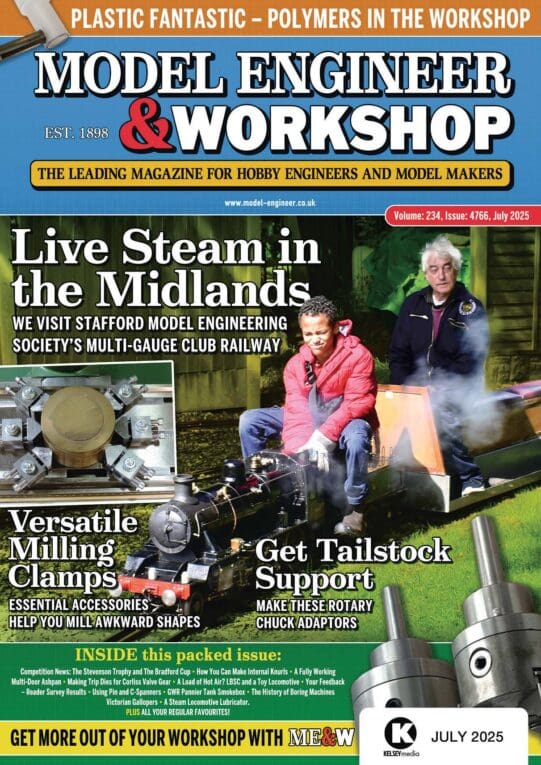Ell81 –
The frame holding the countershaft pulleys looks as if made without a ready way to slacken the flat belt to change speed. So doing that on this lathe will be a pain as Dave says!
It should not be. I don’t suppose it takes more than 15 seconds on my Myford. The usual arrangement has some way to move the countershaft nearer the lathe to allow this, typically controlled by a lever operating an over-centre clamp or an eccentric arrangement so the shaft locks itself in the operating position. So if the frame does not have that quick-tensioning system, I’d investigate making one for it.
Also it looks from that angle as if the belt encloses the back-gear shaft, so fitting a continuous-belt replacement may need that lifting as well. These machines were made for belts that have a joining-clip in them. You thread the belt round the pulleys then assemble the clip to join the ends. An alternative arrangement, used for example on the Myford lathes, is to put the countershaft higher so the belt is entirely clear of the back-gear.
The Vee-belt looks too deeply engaged. Assuming those are standard-profile pulleys (which they might not be!) the correct belt’s outer width is that of the groove top, so it runs with its outer surface pretty well level with the pulley rim.
…
The cutting speed is a bit advisory: you can machine metals at much lower speeds than the books suggest, especially with high-speed steel tools, because the books are based on trade practice where time costs money. It just takes longer! Note though Dave’s warning about excessive speed on a machine like this, with its plain bronze bearings and very basic lubrication.
…..
That slotted cross-slide is a bonus. Its primary purpose is for “boring between centres”, for maching cylinders too long to hold safely and accurately in the chuck. The work is packed up to the right height and clamped to the cross-slide, and the cutter is in a bar driven from the headstock centre or chuck, and supported by the tailstock centre.
Such a slide also allows using accessories like the rear tool-posts many of us use especially (but not only) for parting-tools; angle-plates and vertical slides. The current edition of ME&W carries an article showing such applications.
….
Morse-taper tooling such as centres are readily available from the model-engineering suppliers. The taper shank is of standard length for the diameter so that does not control how much of the lathe is hogged by the tool itself. Drill chucks and some die-holders are the longest.
…..
Howard has explained the change-wheels, on the outside end of the headstock. Disengage these when not being used, to reduce wear; and anyway you will need the leadscrew (the long one along the front of the lathe bed) disengaged from them when using the handwheel on its far end. I take it the disc visible inboard of the handle is a graduated dial?
That leadscrew handwheel is used when you need take a measured cut longer than the top-slide travel gives; by engaging the half-nuts by that lever with the curved slots. Normally you keep the half-nuts disengaged and use the saddle handwheel that drives a pinion engaging the rack fitted to the bed above the leadscrew.
Or set up the change-wheels to give a fine self-acting longitudinal feed using the leadscrew and half-nuts. There are a few change-wheels already on the machine but did the rest of set come with it?
…
That little dial on the right-hand end of the saddle is a thread-indicator, used when screw-cutting. It normally pivots in or out of engagement with the leadscrew, with a pin, screw or nut to hold in either position; and should only be engaged when screw-cutting. Its graduations are not measurements as such but timing points for starting each iteration of the cutting, as it’s normal to take a series of cuts to complete the thread.
…..
A tip on using the tool-clamp. Your top photo seems to show it slanting downwards. It’s best set slanting down but quite gently to give the maximum clamp area gripping the tool shank. Never upwards – than can result in suddenly losing its grip.
The tool itself, ground appropriately for the material, is set so its cutting edge is exactly on the centre-height of the lathe, on a machine like this by using shims under the tool. Introductory books on turning should explain all these points.
The black fitting there on Martin Whittle’s photographed lathe, is a “Quick-Change Tool Post”. A steel block held to the top-slide, clamps to itself separate, channelled blocks that hold the tools themselves. Each has its own adjuster for setting that height. It speeds up repetition work, especially; but you need at least four tool-blocks to make the set worthwhile. You can see four other blocks on the shelf above the machine, in Martin’s photograph.
I made a crude “Quick-ish Change” set of tool-holders for my much smaller EW lathe, by drilling blocks of steel to hold small tool-bits on an incline for height-setting.
……..
It looks a good lathe – keep us posted with progress and do please ask, if you need help!
old fool.












